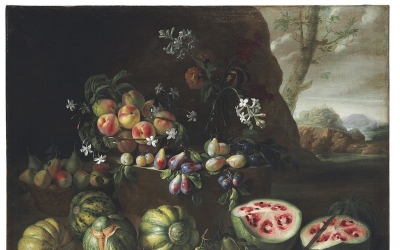- Latest news▼
-
12:27, April 23 Appetite: Scientists found out the secret to the appeal of large portions of fast food

-
10:33, April 23 Scientists test new approach to fighting viruses

-
08:38, April 23 Ketamine may help with postpartum depression

-
22:12, April 22 Unhealthy amount of sugar found in baby food products of a well-known brand

-
19:41, April 22 Air pollution puts health of more than 1.6 billion workers globally at risk

-
17:25, April 22 Scientists found baked goods and lack of sleep to be more dangerous than alcohol

-
16:02, April 22 342 cases of measles recorded in Armenia so far in 2024

-
15:29, April 22 BrainStimulation: electrical brain stimulation alleviates anxiety and depression in the elderly

-
08:27, April 22 Cognitively stimulating jobs in midlife could lower dementia risk in old age, study finds

-
20:37, April 21 Environmental Health Perspectives: Microplastics ingested with food and water can spread from the gut to the brain

-
22:41, April 20 Scientists develop new method to safely stimulate immune cells to fight cancer

-
20:46, April 20 Blood test can determine who is at risk of developing multiple sclerosis - scientists

-
18:36, April 20 Next pandemic likely to be triggered by flu - scientists

-
12:16, April 19 Scientists grow human mini-lungs in lab

-
10:23, April 19 JAMA Oncology: Urine test can help rule out high-grade prostate cancer with almost 100% accuracy, study shows

All materials
A Renaissance painting reveals how breeding changed watermelons

Look in the bottom right corner of this painting. If you've never seen a watermelon like that before, you're not alone. This 17th-century painting by Giovanni Stanchi, courtesy of Christie's, shows a type of watermelon that no one in the modern world has seen.
Stanchi's watermelon, which was painted sometime between 1645 and 1672, offers a glimpse of a time before breeding changed the fruit forever.
James Nienhuis, a horticulture professor at the University of Wisconsin, uses the Stanchi painting in his classes to teach about the history of crop breeding.
"It's fun to go to art museums and see the still-life pictures, and see what our vegetables looked like 500 years ago," he told me. In many cases, it's our only chance to peer into the past, since we can't preserve vegetables for hundreds of years.
The watermelon originally came from Africa, but after domestication it thrived in hot climates in the Middle East and southern Europe. It probably became common in European gardens and markets around 1600. Old watermelons, like the one in Stanchi's picture, likely tasted pretty good — Nienhuis thinks the sugar content would have been reasonably high, since the melons were eaten fresh and occasionally fermented into wine. But they still looked a lot different.
That's because over time, we've bred watermelons to have the bright red color we recognize today. That fleshy interior is actually the watermelon's placenta, which holds the seeds. Before it was fully domesticated, that placenta lacked the high amounts of lycopene that give it the red color. Through hundreds of years of domestication, we've modified smaller watermelons with a white interior into the larger, lycopene-loaded versions we know today.
Of course, we haven't only changed the color of watermelon. Lately, we've also been experimenting with getting rid of the seeds — which Nienhuis reluctantly calls "the logical progression in domestication." Future generations will at least have photographs to understand what watermelons with seeds looked like. But to see the small, white watermelons of the past, they too will have to look at Renaissance art.


Follow NEWS.am Medicine on Facebook and Twitter
- Related News
- Daily Mail: Satiating food reduces cravings for sweets, nutritionist says The specialist explained that often the great inclination towards sweets is caused not only by psychological hunger, but also by physiological (real) hunger…
- Daily Mail: intermittent fasting is not suitable for children and women before their periods Children and teenagers should stay away from it, because their bodies (especially bones) are still growing and developing...
- Food and Environmental Virology: tea contributes to effective coronavirus control According to the scientists, the teas inactivate SARS-CoV-2 in saliva...
- AJCN: Sugar in bread, rice, pasta can cause insomnia in women, study finds As researchers point out, the refined sugar in such foods may be to blame for sleep problems...
- Food Bioscience: dark chocolate supports growth of beneficial gut bacteria This positive effect can be enhanced by adding probiotics...
- Video
- Event calendar
- Archive
- Most read
month
week
day
- JAMA Oncology: Urine test can help rule out high-grade prostate cancer with almost 100% accuracy, study shows 1153
- Daily Mail: Elderly woman in China gets infected with brain-eating amoeba 1138
- Obesity: exercising before breakfast helps you lose weight faster 1124
- The Conversation: childhood trauma can cause pathological hoarding 1121
- Daily Mail: Satiating food reduces cravings for sweets, nutritionist says 1094
- First Armenian-German Conference entitled “Heart Failure Spring School” 1049
- Why do kids usually recover from COVID-19 more easily than adults? 994
- Scientists grow human mini-lungs in lab 956
- Next pandemic likely to be triggered by flu - scientists 501
- Scientists found baked goods and lack of sleep to be more dangerous than alcohol 441
- Blood test can determine who is at risk of developing multiple sclerosis - scientists 409
- Scientists develop new method to safely stimulate immune cells to fight cancer 401
- 342 cases of measles recorded in Armenia so far in 2024 385
- Cognitively stimulating jobs in midlife could lower dementia risk in old age, study finds 380
- BrainStimulation: electrical brain stimulation alleviates anxiety and depression in the elderly 315
- Find us on Facebook
- Poll





